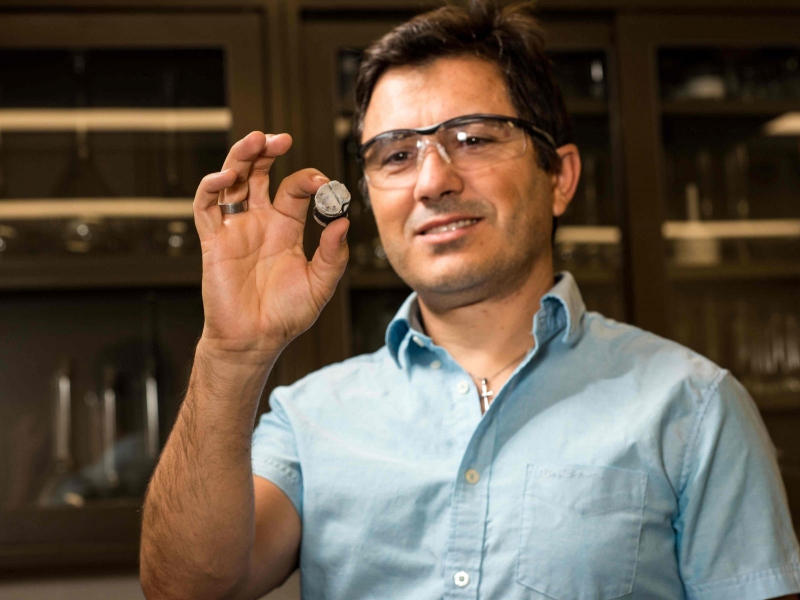Cement that repairs itself within 24 hours. A nontoxic coating that protects against biofouling. A cybersecurity visualization dashboard that will help electric grid operators better monitor for potential cyber threats.
These are a few of the 11 energy-related inventions developed at Pacific Northwest National Laboratory (PNNL) and selected for additional funding to move them from laboratory and field tests to the marketplace. Funding from the U.S. Department of Energy (DOE) Office of Technology Transitions (OTT), combined with 50 percent industry matching, brings the total awarded for PNNL-related projects to more than $9.6 million.
In total, DOE will provide more than $30 million for 68 projects across the national laboratory system supported by OTT's Technology Commercialization Fund (TCF). Created by the Energy Policy Act of 2005, TCF is a program that connects companies with national laboratories. The federal funds are matched by private business partners. Together, they mature energy technologies that have the potential for high impact in the U.S. marketplace-speeding innovations toward commercialization and actual products.

"TCF has been instrumental in helping PNNL to ready technologies for industry. For example, we teamed with Moselle Technologies to advance a magnetic nanoparticles process to capture critical materials, such as lithium, from water sources," said Lee Cheatham, director of PNNL's Technology Deployment and Outreach office. "The start-up business has since licensed the invention and is developing pilot processes at several U.S. and international locations."
PNNL projects awarded 2021 TCF funding include the following:
- Self-Healing Cements for Subsurface Applications
Industry partners: AltaRock Energy, Cyrq Energy, and Resource Cementing
The R&D-100-Award-winning self-healing cement will be field-tested for its durability and scalability for use in geothermal well environments. The cement combines select polymers-strong, flexible, and powerful ingredients-with conventional cement to produce a cement composite that heals itself within one day of when cracks occur.
- Situation Awareness Visualization Dashboard for Grid Cybersecurity
Industry partners: Cyber Capital Partners and Treverity
This visualization tool bridges the communication gap between electric grid control room operators and cybersecurity analysts during a cyberattack. The team will build a configuration tool that will make it easier to deploy the technology with visualization displays that more closely match the real-world operating environment.
- Nontoxic Antifouling Coating for the Marine and Hydrokinetic Industry
Industry partners: Dry Surface Technologies, Lorama Group Inc., Prometheus Innovations LLC, BioBlend Renewable Resources, Taylor Shellfish Farms, and Pacific Netting Products Inc.
The coating, called SLIC (Superhydrophobic Lubricant Infused Composite), is an advanced material that can be applied to critical infrastructure, maritime ships, ocean-rigging platforms, and more to prevent buildup of harmful microorganisms from occurring. The project will further investigate the performance of SLIC in marine environments.
- Scale-up, Field Testing, and Optimization of Nontoxic, Durable, Economical Coatings for Control of Mussels at Hydropower Facilities
Industry partners: Dry Surface Technologies, Lorama Group, Prometheus Innovations LLC, BioBlend Renewable Resources, and Taylor Shellfish Farms
Removing highly invasive zebra and quagga mussels from critical infrastructure, such as hydroelectric plants, is costing industries more than $100 million per year in maintenance and operation fees. PNNL's environmentally friendly SLIC coating will be field-tested at hydropower dams across the United States.
- Enhancing Lifetime and Reducing Costs for Fish Diversion Netting Structures
Industry partners: Dry Surface Technologies, Lorama Group, Prometheus Innovations LLC, BioBlend Renewable Resources, Taylor Shellfish Farms, and Pacific Netting Products Inc.
This project will demonstrate the flexible SLIC coating on netting used to divert fish around hydro, marine, and hydrokinetic structures.
- Remote Deployment and Setup of VOLTTRONTM Instances
Industry partner: Intellimation
VOLTTRONTM is a software platform that communicates with building equipment, sensors, and other physical devices to independently manage a wide range of building services. Through this project, the team will increase the pool of users who can install and configure the platform.
- Distributed Energy Resources as a Service
Industry partner: ecoLong LLC
The VOLTTRONTM platform will be demonstrated at multiple sites in the state of New York to test its viability as a solution for use as a secure residential energy management system that allows distributed energy resources to participate in wholesale markets and provide services onto the grid.
- Common Information Model for Electromagnet Transients
Industry partners: PGSTech, PacifiCorp, and Midcontinent Independent System Operator
Using an open-source software tool developed at PNNL, the project will help electric utilities perform the larger, more detailed studies needed to integrate massive amounts of solar, energy storage, and wind resources onto the grid.
- Aluminization Coatings and Glass Seals for H2Gen Reactors
Industry partner: Utility Global
Drawing on PNNL's portfolio of patented glass sealing and coating technologies for high-temperature electrochemical devices, the team will test and validate potential solutions that could help solve the partner's technical challenges with forming gastight seals in its H2Gen reactor technology.
- Mesofluidic Inline Separation for Produced Water Treatment
Industry partner: APEX Petroleum Engineering
The Mesofluidic Separator filters particles out of liquid slurries to keep unwanted solids or chemicals from downstream processes. The separator will be tested for use in filtering and reuse of produced water from sources such as agriculture, industrial use, and surface discharge, among others.
- MEMS-Enabled In Operando Spectroscopy and Imaging During Heating
Industry partners: Norcada Inc. and SPECS GmbH
High temperatures often occur in nuclear material processing and storage, and it can cause material degradation and corrosion. The team will design new microreactors and integrate micro-electromechanical system techniques for real-time heating and simultaneous imaging and spectroscopy for use in electron microscopy studies.
To learn more about PNNL's available technologies






